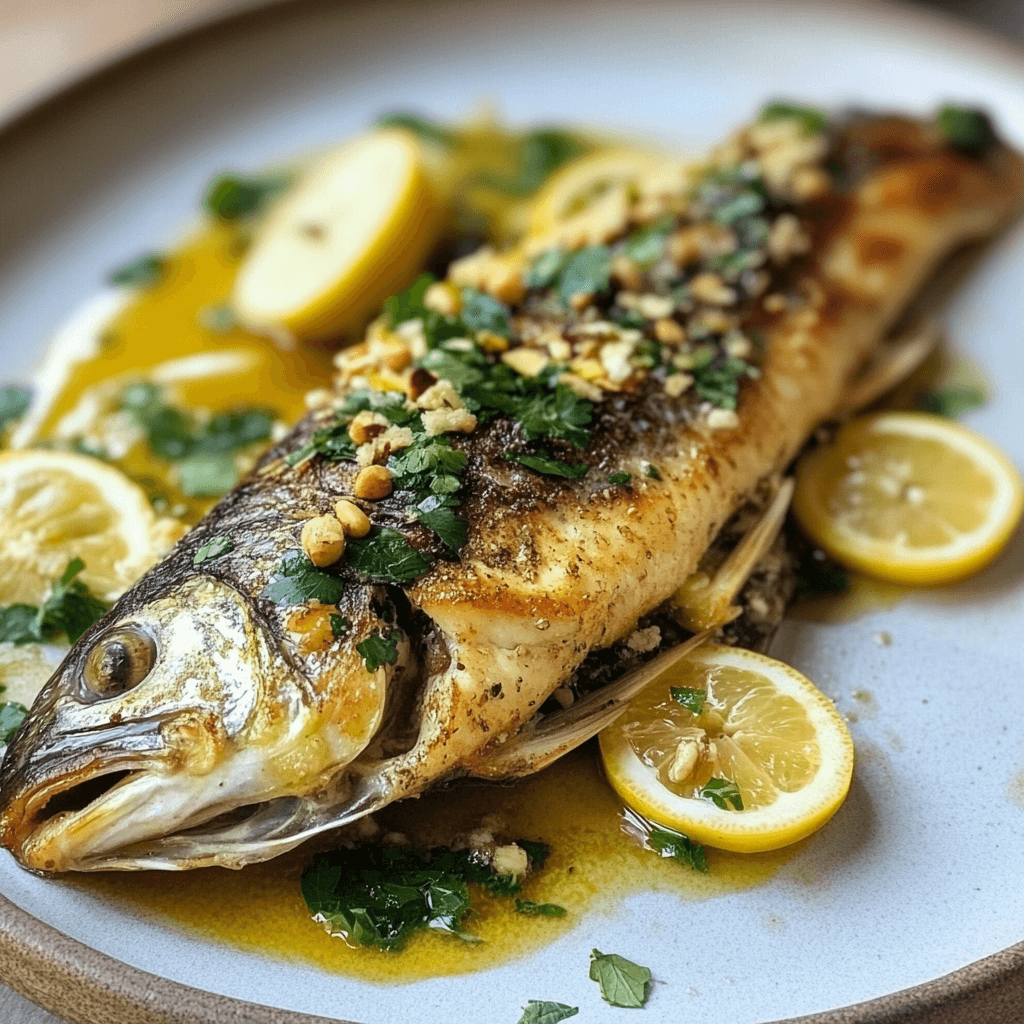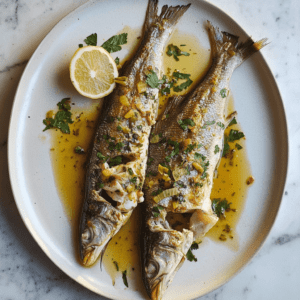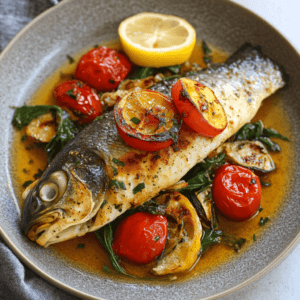If you’re new to seafood, learning how do you cook and eat branzino can transform your dining experience into something special.
Branzino, a Mediterranean delight, is as versatile as it is flavorful. But how do you cook and eat branzino to make the most of its tender texture and delicate taste? This guide will teach you everything from selecting fresh branzino to mastering recipes that highlight its natural flavors. With simple steps and expert tips, you’ll confidently prepare this seafood favorite.
What Is Branzino and How Do You Cook and Eat Branzino?
What Is Branzino?
Branzino, scientifically referred to as Dicentrarchus labrax, is a saltwater fish commonly found in the Mediterranean Sea and parts of the eastern Atlantic Ocean. Known for its mild, slightly sweet flavor and flaky white flesh, branzino is a versatile choice for a variety of cooking methods. It’s particularly popular in Italian, Greek, and other Mediterranean cuisines.
Why Branzino Is Popular
Health Benefits and Nutritional Value
Branzino is not only delicious but also highly nutritious. This lean source of protein is rich in omega-3 fatty acids, which are vital for maintaining heart health, reducing inflammation, and supporting brain function. Additionally, it provides an excellent supply of essential vitamins such as B12 and D, as well as minerals like selenium and potassium, which contribute to overall well-being.
Compared to many other types of fish, Branzino has a low mercury content, making it a safe and healthy option for regular consumption. Its impressive nutritional profile, combined with its versatility in the kitchen, makes Branzino a favorite choice for home cooks and professional chefs alike. Whether baked, grilled, or pan-seared, this fish is a delicious way to enjoy both flavor and health benefits.
Selecting the Perfect Branzino
Fresh vs. Frozen: How to Choose the Best Fish
When selecting branzino, freshness is key. Look for the following signs to ensure you’re picking the best:
- Eyes: Clear, bright eyes indicate freshness, while dull or sunken eyes suggest the fish is past its prime.
- Skin: The scales should be shiny and moist, not dry or flaky.
- Smell: Fresh branzino has a mild, oceanic scent. Avoid fish with a strong, fishy odor.
- Gills: If visible, the gills should be bright red or pink.
Frozen Branzino is a great alternative when fresh fish isn’t available. To ensure quality, choose fish that is vacuum-sealed and free from frost or any signs of freezer burn. When ready to use, thaw the frozen fish in the refrigerator overnight for optimal results. This gradual thawing process helps preserve the texture and flavor, ensuring a delicious meal.
Essential Tools and Ingredients
Tools for Preparing Branzino
To prepare branzino effectively, you’ll need the following tools:
- Sharp Fillet Knife: Essential for cleaning, deboning, and portioning the fish.
- Fish Scaler: A tool to remove the scales without damaging the flesh.
- Kitchen Shears: Useful for trimming fins and cutting through the backbone if needed.
- Tongs: Ideal for flipping the fish during grilling or pan-searing.
- Baking Sheet or Grill Pan: Depending on your cooking method.
- Parchment Paper: For mess-free baking.
Ingredients for Cooking Branzino
Branzino shines when paired with simple, fresh ingredients. Common staples include:
- Olive Oil: A Mediterranean essential for cooking and drizzling.
- Lemon: Adds brightness and balances the fish’s natural richness.
- Garlic: Enhances flavor when roasted or sautéed.
- Herbs: Thyme, parsley, dill, and rosemary are popular choices.
- Seasonings: Kosher salt, black pepper, and optional chili flakes for heat.
Simple Steps to Prepare and Cook Branzino
Cleaning and Gutting the Fish
If you’ve purchased whole branzino, you’ll need to clean and gut it. Here’s how:
- Scaling: Use a fish scaler or the back of a knife to remove scales. Work from tail to head.
- Gutting: Insert a knife into the belly, just behind the gills, and cut toward the tail. Remove the innards and rinse the cavity thoroughly.
- Trimming: Use kitchen shears to remove the fins and tail for a cleaner presentation.
Deboning or Cooking Whole: Which Is Better?
Cooking Branzino whole is an excellent way to enhance its flavor and retain its natural moisture, resulting in a tender and juicy dish. However, serving the fish whole can make it slightly more challenging to eat due to the bones. To offer the best of both worlds, consider deboning the fish after cooking. This approach preserves the benefits of cooking it whole while making it easier for your guests to enjoy. Presenting the deboned fillets neatly on a platter ensures a seamless and enjoyable dining experience.
Cooking Techniques for Branzino
Grilling Branzino: Tips and Tricks
Grilling is a popular method that adds a smoky char to branzino. Follow these steps:
- Preparation: Score the skin to prevent curling. Rub the fish with olive oil and season with salt, pepper, and herbs.
- Grill Setup: Preheat the grill to medium heat. Ensure the grates are clean and lightly oiled.
- Cooking: Place the fish directly on the grill. Cook for 4-5 minutes per side, depending on size, until the skin is crisp and the flesh is opaque.
Baking Branzino for Perfect Results
Oven-baking is a foolproof method that’s ideal for beginners. Here’s how:
- Preparation: Preheat the oven to 375°F (190°C). Line a baking sheet with parchment paper.
- Stuffing: Fill the cavity with lemon slices, garlic cloves, and fresh herbs.
- Baking: Drizzle the fish with olive oil and bake for 20-25 minutes, or until the internal temperature reaches 145°F (63°C).
Pan-Frying Branzino for Crispiness
Pan-frying creates crispy skin while keeping the flesh moist. Try this method:
- Preparation: Pat the fish dry to prevent splattering. Season with salt and pepper.
- Cooking: Heat oil in a skillet over medium-high heat. Place the fish skin-side down and cook for 3-4 minutes. Flip and cook for another 2-3 minutes.
Enhancing Flavors
Best Herbs and Spices for Branzino
Branzino’s mild, delicate flavor pairs wonderfully with Mediterranean herbs such as thyme, dill, parsley, and oregano, which complement its natural taste without overwhelming it. For those looking to create a bolder flavor profile, consider adding spices like smoked paprika, cumin, or even a hint of curry powder. These additions bring warmth and complexity to the dish, showcasing Branzino’s versatility in adapting to a wide range of culinary styles and seasonings.
Lemon and Olive Oil: Classic Pairings
A drizzle of high-quality olive oil and a squeeze of fresh lemon juice are all it takes to elevate Branzino to perfection. These simple yet classic pairings enhance the fish’s delicate, natural flavors without overpowering them, allowing its tender, flaky texture to shine. This minimalistic approach embodies the essence of Mediterranean cuisine, where fresh, quality ingredients take center stage.
Step-by-Step Branzino Recipes
Grilled Branzino with Mediterranean Vegetables
- Ingredients: Whole branzino, zucchini, bell peppers, cherry tomatoes, olive oil, herbs.
- Method: Stuff the fish with herbs and lemon slices. Grill alongside seasoned vegetables for a complete meal.
Oven-Baked Branzino with Garlic and Herbs
- Ingredients: Whole branzino, garlic cloves, fresh rosemary, olive oil.
- Method: Place the fish on a baking sheet, surround with garlic cloves, and roast until tender and aromatic.
Pan-Seared Branzino with White Wine Sauce
- Ingredients: Branzino fillets, white wine, butter, parsley, shallots.
- Method: Sear the fillets, then deglaze the pan with white wine. Add butter and parsley for a rich, flavorful sauce.
How Do You Cook and Eat Branzino with Mediterranean Flavors?
Removing Bones While Eating
To enjoy branzino with minimal effort, follow these steps:
- Use a fork to lift the top fillet off the bones.
- Remove the backbone in one piece if possible.
- Enjoy the lower fillet, checking for any small pin bones.
Pairing Branzino with Sides
Complement branzino with light, flavorful sides such as:
- Roasted potatoes
- Couscous or rice pilaf
- Steamed or grilled vegetables
- Fresh arugula salad
Branzino and Global Cuisine
Branzino in Italian Cuisine
Italian chefs frequently prepare Branzino al Forno, a classic baked dish featuring the fish alongside tomatoes, olives, and capers. This combination of briny and fresh ingredients creates a beautifully balanced flavor profile that is quintessentially Mediterranean. The dish is simple yet elegant, highlighting the natural taste of the fish while infusing it with the rich, savory notes of the accompanying ingredients. Perfect for a comforting meal with a touch of sophistication, Branzino al Forno exemplifies the essence of Italian coastal cuisine.
Branzino in Mediterranean Dishes
In Greece, Branzino is often grilled to perfection and served with ladolemono, a traditional lemon-olive oil dressing that enhances the fish’s natural flavor with a tangy, zesty touch. In Turkish cuisine, Branzino is sometimes marinated in a mixture of yogurt and spices, such as paprika, cumin, and garlic, before cooking. This method adds a creamy, aromatic layer of flavor, showcasing the fish’s versatility across Mediterranean and Middle Eastern culinary traditions.
Tips for Serving Branzino
Presentation Ideas
For a dramatic and eye-catching presentation, serve whole Branzino on a large platter, garnished with fresh herbs, lemon slices, and perhaps some roasted vegetables. Alternatively, for a more refined and elegant approach, serve neatly plated fillets accompanied by a drizzle of flavorful sauce, such as lemon-butter or herb-infused olive oil. Both styles offer an impressive and appetizing way to present this versatile fish.
Wine Pairings for Branzino
A crisp white wine, such as Sauvignon Blanc, or a dry rosé makes an excellent pairing with Branzino, complementing its delicate and flaky texture without overpowering its flavor. For those who prefer a more robust option, a light Pinot Noir with subtle fruitiness and low tannins can also pair beautifully, providing a balanced contrast that enhances the dining experience.
Storing Leftover Branzino
Refrigerating Branzino Safely
Store leftovers in an airtight container to preserve freshness and prevent contamination. Refrigerate promptly, ideally within two hours of cooking, to maintain food safety and quality. For the best flavor and texture, consume the leftovers within 2–3 days. Proper storage ensures the fish remains delicious and safe to enjoy as a quick and convenient meal.
Reheating Tips for Best Taste
To reheat Branzino while maintaining its delicate texture and flavor, use an oven set to 300°F (150°C). Place the fish on a baking sheet lined with parchment paper or foil to prevent sticking and cover it loosely with foil to retain moisture. Heat it for about 10–15 minutes, or until warmed through, checking occasionally to avoid overcooking. Avoid reheating Branzino in a microwave, as the high heat can make the fish rubbery, dry, and less enjoyable to eat. Using the oven ensures the fish remains tender and flavorful, providing a satisfying meal even as leftovers.
FAQs About Cooking and Eating Branzino
- Can you eat branzino skin?
Absolutely! When cooked properly, the skin becomes crispy and delicious. - What’s the easiest way to debone branzino?
After cooking, use a sharp knife to carefully remove the backbone, then gently separate the fillets for easy serving. - Can you freeze leftover branzino?
Yes, wrap the fish tightly in plastic wrap and store it in the freezer for up to 2 months to maintain its freshness and quality. - What’s a simple branzino seasoning?
A simple combination of olive oil, lemon, salt, and pepper creates a classic and elegant flavor that beautifully enhances the natural taste of the fish. - How do you know when branzino is cooked?
The flesh should be opaque and should easily flake apart with a fork, indicating that the fish is perfectly cooked and ready to enjoy. - What sides complement branzino best?
Light, fresh sides such as roasted vegetables or a vibrant citrus salad are ideal for complementing Branzino. The roasted vegetables add a touch of warmth and smokiness, while the citrus salad brings a bright, tangy freshness that enhances the fish’s delicate flavor. Together, they create a balanced and satisfying meal that’s both healthy and delicious.
Conclusion
Cooking and eating branzino is a rewarding experience that combines simplicity with elegance. From its health benefits to its exquisite flavor, this Mediterranean delight deserves a place in your culinary repertoire. Follow these tips, recipes, and techniques to enjoy branzino to its fullest.
Related article:
What pairs well with branzino?
Is Branzino a Good Fish to Eat? A Detailed Guide
Do You Eat the Skin on Branzino?
The Ultimate Branzino Fillet Recipe: A Step-by-Step Guide to Perfect Results



